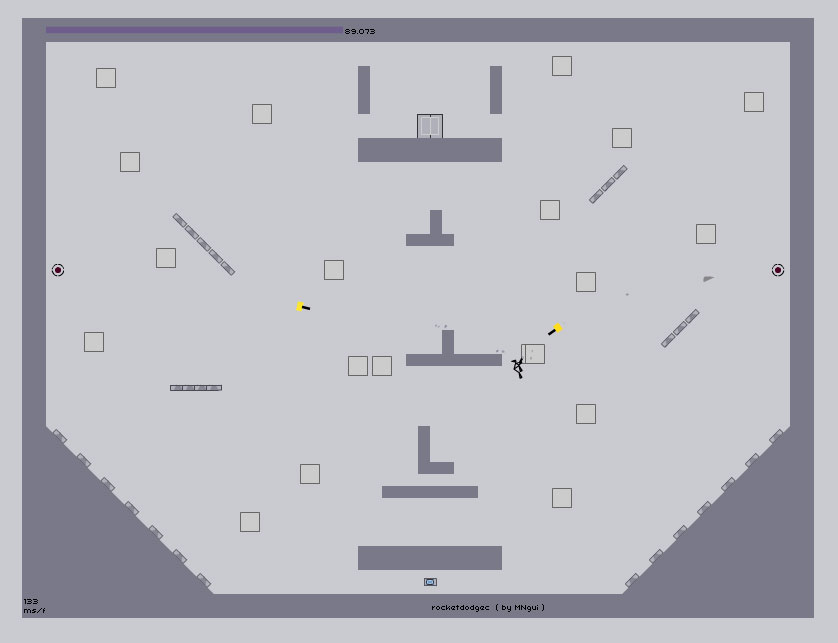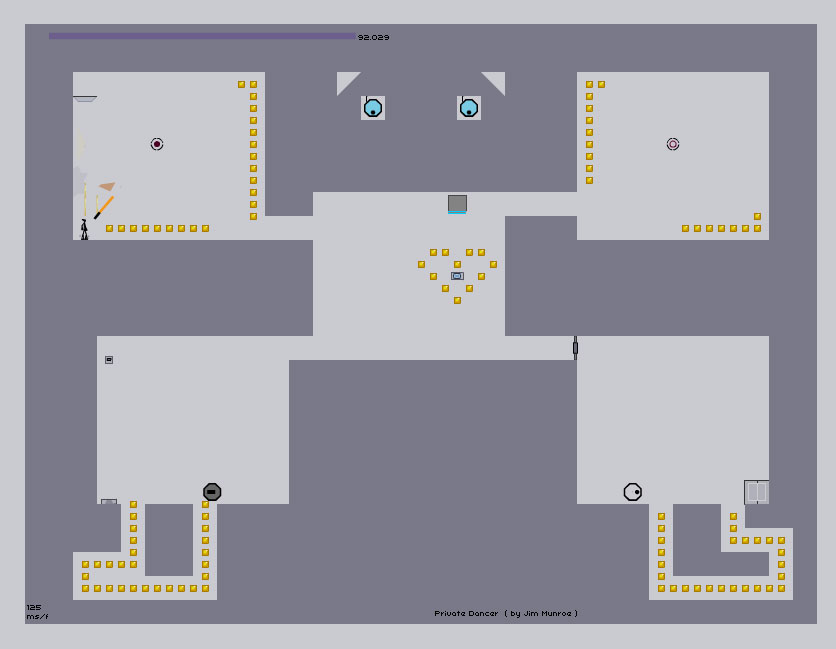Session Two
We began the session with the N levels designs.
Chris had found NED (the N level editor) easier to use than he expected, and was able to realize his map. However, he wasn’t able to figure out how to play his level once he had designed it, and consequently when we playtested it together the N character died in an expected way. This led to a discussion on how playtesting was such an integral part of level design, not to mention fun. Chris said he’d work on his level now he knew how to playtest it and that we could give him feedback next session.
Marc’s level was up next, and he said that he was chiefly inspired by the heat seeking missiles. He had made a previous level that was too hard and consequently removed an enemy or two to make it more fun. Jim played it several times, dying quickly, and Marc noted that the impatient “start again” button pushing was a good sign that it was engaging. Chris then played it a few times and was able to beat it.

Jim’s level was more action oriented. He said he decided to start with a filled up map where he was able to carve out a map rather than starting with a blank map, since that was as intimidating as a blank page. He started by doodling a shape of a dancing crab creature and then adding a gold heart around the action triggers. He found that once he got the basic things working, he wanted to add more and more enemies until it was fun for him to play. He realized it was going to be frustrating for a complete novice but he wanted to create a level that was engaging for himself.

Having a very flexible programming language meant that they could change from text input to point and click, but this also left them with having to rewrite or rethink a lot of the game — the flexibility actually made progress more difficult in some ways. When they tested the game people had a hard time giving the “correct input” that triggered the reward or progression in the game. Emily also was unaware of the many tools with fully developed parsers that would have made her text input handling much easier than writing one from scratch.
This segued nicely into a demo of the Inform 7 game design system. Inform 7 compiles natural language code into a working text game. Jim had a sample game he’d started as an example of how it worked, specifically how it handled graphics — the game was able to display jpgs when you entered a new room, or examined an object. It also had the advantage of being able to be deployed via the web as a java app. However, when Jim went off script and tried to write a game on the fly, the compiler threw up errors and it was obvious that the “natural language” was fairly rigid in its requirements. This put people off of it, as well as the fact that while it may not be code, it was still a lot of text.
Far more popular was Scratch. Upon loading up the graphical interface, people reacted positively — it’s very approachable. Jim showed how the cat can be made to dance, how Emily’s graphics from her previous game can be brought in, and how a sprite can be moved left and right with the arrow buttons. Emily asked if the legs would have to be separate to make them look like they’re moving realistically, and Jim explained that by swapping out different “costumes” for the sprite, animation would give that illusion. Then he showed people a few of the demo games included with it — the pong clone, and then the fish eating game. He showed how the collision detection was implemented by a simple “when colour x hits colour y” command and people found that interesting — these simple games reveal a lot of the tricks game makers use.
This week’s assignment was to mod one or two of the games in the Scratch system — changing the graphics, sounds or behaviours to make a better game. People were quite excited about this.
Jim then demoed a game made by Game Maker called Johny’s Nightmare. Although it’s unlikely the Mac-centric group will be using the PC-only Game Maker system, it was interesting to see a more innovative game made by a point and click system. Emily was impressed by the game’s Little Prince-esque cartoon art, and the “shadows” left behind when you died at a certain point; Marc liked the strange artifacts left as the character slid along the ground. Jim appreciated the pacing of the environment — the gameplay was very simple but there was constantly new and surreal elements scrolling into view.
You must be logged in to post a comment.

Leave a Reply